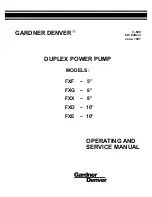
6
7.
Continue feeding cable into the drain until the
obstruction is reached.
8.
When the clog is reached, move the cable in a back
and forth motion until the obstruction is cleared.
Feeding and Retracting Cable
To
feed
the cable:
1. Grasp the cable close to the front collar and pull
enough cable from the machine to start cable
in the drain opening.
WARNING!
Always wear
leather gloves over latex/rubber gloves to avoid
entanglement.
2. Turn forward/off/reverse switch to forward
.
3. Pull 6-8" of cable from the tool.
4. Press down on lever arm with one hand while
guiding the cable down the line with the other.
5. Release lever arm.
6. Repeat steps 3-6 until obstruction is reached.
To
retract
the cable:
1. Ensure forward/off/reverse switch is in forward
.
2. Press down on lever arm.
3.
With gloved hand pull cable from the drain line
until loop forms.
4. Release lever arm.
5. Feed cable back through the machine.
6. Repeat steps 2-5 until all cable removed from the line.
NOTE:
See "Inserting Cable into Drain" for further
instructions.
To Unbind Cable
1. Turn the forward/off/reverse switch to the reverse
position
.
2. Withdraw the cable a few inches while in reverse
to free the cable.
3. Stop the tool.
4. After the tool has come to a complete stop, switch
forward/off/reverse switch back to the forward
position
.
CAUTION
Running the tool in reverse for ex-
tended periods can cause damage
to the cable and accessories.
Removing Cable from Drain
1. Turn the forward/off/reverse switch to the reverse
position
.
2. Press down on the lever arm.
3. Release off lever arm when connector coupling
reached.
4. Disconnect from connector coupling.
5. Place cable in cable container.
6. Repeat steps 2-4 until all cable is free from the drain.
7. Before storing the tool, wash the cable and guide
hose (see "cleaning cables, guide hose and ma-
chine" in maintenance).
MAINTENANCE
WARNING
To reduce the risk of injury, always
unplug the charger and remove the
battery pack from the charger or tool before
performing any maintenance. Never disassemble
the tool, battery pack or charger. Contact a
MILWAUKEE service facility for ALL repairs.
Maintaining Tool
Keep your tool, battery pack and charger in good
repair by adopting a regular maintenance program.
Inspect your tool for issues such as undue noise,
misalignment or binding of moving parts, breakage of
parts, or any other condition that may affect the tool
operation. Return the tool, battery pack, and charger
to a MILWAUKEE service facility for repair. After six
months to one year, depending on use, return the
tool, battery pack and charger to a MILWAUKEE
service facility for inspection.
If the tool does not start or operate at full power with
a fully charged battery pack, clean the contacts on
the battery pack. If the tool still does not work prop
-
erly, return the tool, charger and battery pack, to a
MILWAUKEE service facility for repairs.
ONE-KEY™
WARNING
Chemical Burn Hazard.
This device contains a
lithium button/coin cell battery. A new
or used battery can cause severe in
-
ternal burns and lead to death in as
little as 2 hours if swallowed or enters the body.
Always secure the battery cover. If it does not
close securely, stop using the device, remove the
batteries, and keep it away from children. If you
think batteries may have been swallowed or en
-
tered the body, seek immediate medical attention.
Internal Battery
An internal battery is used to facilitate full ONE-KEY™
functionality. The internal battery is located inside of
the M18™ battery door.
To replace the battery:
1. Remove the battery pack.
2. Remove the screw(s) and open the battery door.
3. Remove the old battery, keep it away from children,
and dispose of it properly.
4. Insert the new battery (3V CR2032), with the posi
-
tive side facing up.
5. Close the battery door and tighten the screw(s)
securely.
WARNING
To reduce the risk of personal in-
jury and damage, never immerse
your tool, battery pack or charger in liquid or
allow a liquid to flow inside them.
Cleaning
Clean dust and debris from vents. Keep handles
clean, dry and free of oil or grease. Use only mild
soap and a damp cloth to clean, since certain clean-
ing agents and solvents are harmful to plastics and
other insulated parts. Some of these include gasoline,
turpentine, lacquer thinner, paint thinner, chlorinated
cleaning solvents, ammonia and household deter-
gents containing ammonia. Never use flammable or
combustible solvents around tools.
Cleaning Cables, Guide Hose and Machine
The cable and guide hose should be thoroughly
flushed with water after every use to prevent damag
-
ing effects of sediment and drain cleaning compounds.
WARNING!
Always wear leather gloves over latex/
rubber gloves to avoid entanglement. After washing,
dry the cable and guide hose completely. Then, wipe
cable with an oiled rag before returning it to its carrier.
Cleanout procedure:
1. Insert the battery pack and close the battery door.
Switch the tool into forward position
.
2. Press lever and run tool for 30 seconds. Insert
cable and check function.
3. Tip tool on an angle with the front of the tool point
-
ing upward.
4. Flush the tool continually with water until all com
-
ponents appear to be moving freely.
5. Repeat steps 2-6 until all components are moving
freely.






































